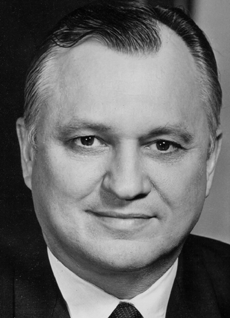Walter Hickel
| Wally Hickel | |
|---|---|
 |
|
| 2nd and 8th Governor of Alaska | |
|
In office December 3, 1990 – December 5, 1994 |
|
| Lieutenant | Jack Coghill |
| Preceded by | Steve Cowper |
| Succeeded by | Tony Knowles |
|
In office December 5, 1966 – January 29, 1969 |
|
| Lieutenant | Keith Harvey Miller |
| Preceded by | William A. Egan |
| Succeeded by | Keith Harvey Miller |
| 38th United States Secretary of the Interior | |
|
In office January 24, 1969 – November 25, 1970 |
|
| President | Richard Nixon |
| Preceded by | Stewart Udall |
| Succeeded by | Rogers Morton |
| Personal details | |
| Born |
Walter Joseph Hickel August 18, 1919 Ellinwood, Kansas, U.S.. |
| Died | May 7, 2010 (aged 90) Anchorage, Alaska, U.S. |
| Resting place |
Anchorage Memorial Park Anchorage, Alaska, U.S. |
| Political party |
Republican Party (ca. 1940-1990, 1994-2010) |
| Other political affiliations |
Alaskan Independence Party (September 1990 – April 1994) |
| Spouse(s) | Jannice Hickel (née Cannon; 1941–1943, her death) Ermalee Hickel (née Strutz; 1945–2010, his death) |
| Children | Theodore Jeffrey "Ted" Hickel Robert "Bob" Hickel Walter Joseph "Wally" Hickel, Jr. John Edward "Jack" Hickel Joseph William "Joe" Hickel William Karl "Karl" Hickel |
| Signature | |
Walter Joseph "Wally" Hickel (August 18, 1919 – May 7, 2010) was an American businessman and politician. Starting out in Alaska during territorial days as a construction worker and subsequently a construction company owner/operator, he later became heavily involved with real estate development during Alaska's post-World War II boom period, building residential subdivisions at first, then branching out to building and operating shopping centers and hotels. Thrust into politics during the early 1950s by a power struggle within the territorial Republican Party and the battle to achieve statehood for Alaska, Hickel remained a formidable power in Alaskan politics for nearly a half century.
Hickel served as the second and eighth Governor of Alaska. Defeating incumbent and first governor William A. Egan in 1966, he served as governor until 1969, ending with his resignation upon his confirmation in the position of United States Secretary of the Interior in the cabinet of President Richard Nixon. He later served a full term as governor from 1990 to 1994 under the banner of the Alaskan Independence Party, thus far the party's most significant electoral achievement.
Born in Ellinwood, Kansas in 1919, he grew up on his parents' Dust Bowl tenant farm during the Great Depression near Claflin, Kansas. Hickel relocated to Alaska in 1940, going into the local real estate industry. By 1947, Hickel had formed a successful construction company. While some fellow Republicans in the Alaska Territory opposed statehood, Hickel joined Democrats in calls for joining the Union during the late 1940s and into the 1950s. Using his growing popularity among Alaskan Republicans and growing political clout in Washington, Hickel was able to travel to the nation's capital to engage in talks with key Republicans in both the U.S. Congress and within the Eisenhower Administration to speak about Alaskan statehood. Thanks in part to his efforts, Hickel's debates with Congressional leaders led to enough initially hesitant Republicans voting in favor of the Alaska Statehood Act in 1958.
...
Wikipedia
